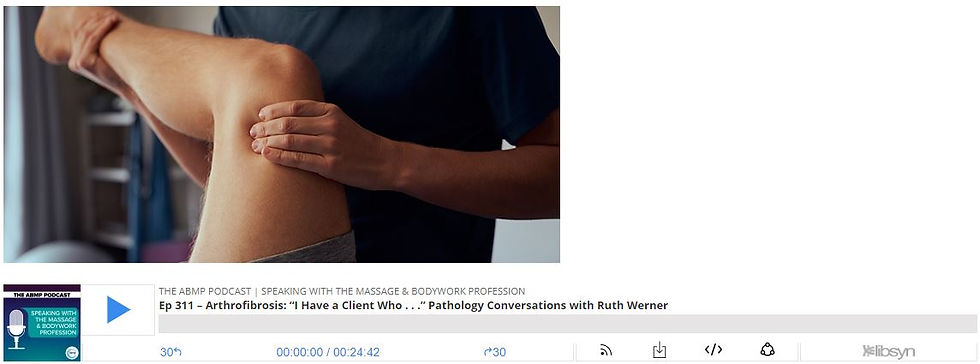Pathology Perspectives: Arthrofibrosis
- IAA

- Apr 22, 2023
- 2 min read
The Associated Bodywork & Massage Professionals supports and educates massage therapists, bodyworkers, students, and other educators. With 10 800 subscribers and 594 videos, the ABMP is the largest association of massage and bodywork practitioners in the United States, and feature the top columnists and new voices in the profession discussing the issues, techniques, and news.
In this video massage educator, podcaster and author Ruth Werner talks to Dr Kayley Usher about how Dr Usher came to be involved with arthrofibrosis, why she wrote the influential review paper about the pathology of arthrofibrosis, and then established the International Arthrofibrosis Association. Ruth Werner asks why we haven’t heard about arthrofibrosis before, when it is implicated in around 30 % of failures after an ACL reconstruction. They discuss the differences between active, inflammatory arthrofibrosis and residual arthrofibrosis in which the inflammation has resolved, but the scar tissue continues to restrict range of motion.
They discuss the differences between active, inflammatory arthrofibrosis and residual arthrofibrosis
Dr Usher emphasises the importance of not “pushing through the pain” and the need to be extremely careful for around a year after resolution (if that happens) due to the risk of reactivating the condition. Ruth Werner observes that the more we learn about myofibroblasts the more opportunities we have to intervene early in the pathology.
About Ruth Werner
Ruth Werner is a former massage therapist, a writer, and an NCBTMB-approved continuing education provider. She wrote A Massage Therapist’s Guide to Pathology (available at booksofdiscovery.com), now in its seventh edition, which is used in massage schools worldwide. Werner is available at ruthwerner.com.
She interviewed Dr Kayley Usher before in this 24 minute podcast in which she clearly explains the pathology of arthrofibrosis.
A client’s knee surgery seemed to go OK, but now he has a problem: his knee is stuck in 60 degrees of flexion. His doctors don’t seem interested in his diagnosis, leading him to wonder if anything will ever change. What’s going on? Is this unusual? Turns out, it might happen a lot. But massage therapy might be helpful, according to one of the world’s leading experts on the subject. Join us as we explore arthrofibrosis in this edition of “I Have a Client Who . . . ”









Comments